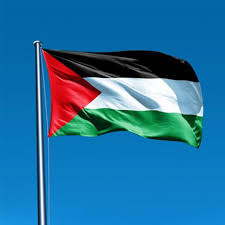
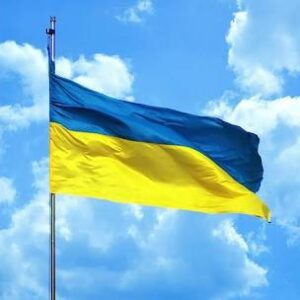
Please pray for the suffering people of Ukraine and the Palestinian people of Gaza and the West Bank. Pray for an end to these unjust and immoral wars.
+ + +
The Orthodox Saints of October 24
Martyr Arethas (al-Haarith) and over 4,000 with him, including Martyr Syncletica and her two daughters; Blessed Elesbaan (Caleb), king of Ethiopia; Saint Athanasius, Patriarch of Constantinople; Saint Arethas, Sisoes, and Theophilus the Silent, recluses of the Kiev Caves; Saint Senoch, Abbot of Tours (Gaul); New-Martyr Bishop Lawrence of Balakin; Saint John the Hermit of Pskov; Martyr Sebastian; Saint Maglorios, Abbot of Sark; Saints Mark, Soterikos, and Valentinos; Saints Akakios the presbyter and Nerdon; Icon of the Most Holy Theotokos “The Joy of All Who Sorrow;” repose of Blessed Elder Zosimas (Verkhovsky) (taken from Orthodox Wiki)
Are these the only saints who died on October 24? No. These are the ones who were well enough known in their time and to be remembered. In number they are like the people we see and hear about in the media today, as compared to all the rest of the people in the world. Besides the remembered saints, there are countless ordinary men and women and children who gave their lives for Jesus Christ in one way or another, including a vast number of martyrs during imperial persecution in the early centuries, and far more during Communist persecution in the 20th Century.
The book of Hebrews speaks the truth when it says “we are surrounded by so great a cloud of witnesses…” Hebrews 12:1
At Sunday Divine Liturgy we’re accustomed to hearing a few of these well-known saints commemorated by name. (Are you listening?) I hope your pastor tells you a little about one or two of them. They set forth examples for us to emulate, saints whose prayers we can request. It’s also an easy way for people to learn a bit about Church history.
However, if your pastor told you the stories of all of them in any detail, we’d be in church all day and most of the night.
I will now try to cover today’s.
Martyr Arethas (al-Haarith) and over 4,000 with him, including Martyr Syncletica and her two daughters
This is the major commemoration of the day, so I’ll cover it in some detail. I’m guided in this by John Sadinopoulos’ Mystagogy Resource Center (https://www.mystagogyresourcecenter.com) where we can find an enormous amount of information, not only about the saints but about Orthodoxy in general. He has given me permission to quote from his work. In what follows my few comments are in italics. I have omitted some portions that are extremely gruesome.
“These Martyrs contested for piety’s sake in the year 524 in Najran, a city of Arabia Felix, present-day Yemen. * When Dhu Nuwas, ruler of the Himyarite tribe in south Arabia, and a Judaizer (convert to Judaism), took power over King Elesbaan of Ethiopia who ruled in that area, he sought to blot out Christianity, especially at Najran, a Christian city. Against the counsels of Arethas, Governor of Najran, the city surrendered to Dhu Nuwas, who immediately broke the word that he would come in peace which he had given and sought to compel the city to renounce Christ.”
- Did you know Christianity once existed in Arabia?
“The tyrant first wreaked his wrath on the holy bishop Paul, who had died two years before. Now he had his tomb opened and ordered his holy and much venerated relics to be burnt. He went on to burn all the priests, monks, nuns and clergy in the city, to the number of 477 persons. Then he beheaded 127 pious layfolk who offered their life to Christ. He had a rich widow, a noblewoman, brought before him. When persuasion failed its purpose, he threatened dreadful tortures if she would not deny her Christian faith. Her daughter, seeing her mother insulted by the tyrant and ill-treated by his soldiers, ran to Dhu Nuwas and spat in his face. He was enraged and had the twelve year old girl immediately beheaded. Then, in the height of cruelty…” After this the story becomes so gruesome that I won’t include it here.
“Then, led by Saint Arethas, 340 Christians were brought before the tyrant. Arethas had to be carried to the place of judgement, for so distressed was he at seeing in his old age such torments raining down upon his fellow-citizens, that his strength left him. Yet he still showed confidence and courage before the King, and meekly and calmly he encouraged his companions to reach perfection by way of martyrdom and to do so joyfully in the name of the Lord that they may enter into His joy in glory. The people wept at his speech and all embraced one another with tears, giving each other a holy kiss. Arethas was beheaded first, and after all the people anointed their foreheads with his blood, they met their death with joy…” Again the story becomes horribly gory. Look it up on Mystagogy, if you wish and think you have the stomach for it.
“The notoriety of the massacre at Najran reached the ears of Emperor Justin at Constantinople. He wrote to Asterios, the Patriarch of Alexandria, asking him to urge King Elesbaan of Ethiopia to mount an expedition against Dhu Nuwas. In alliance with Byzantium, King Elesbaan liberated Najran from Dhu Nuwas soon after and raised up churches in honor of the Martyrs. Najran became a place of pilgrimage until the rise of Islam a century later. At the end of his life King Elesbaan, who was also called Kaleb, retired into solitude as a hermit; he sent his crown to Jerusalem as an offering to the Church of the Holy Sepulchre. He also is commemorated on this day as a saint.”
Now, the rest of this Post is written in my own words, summarizing the sometimes-long stories of the saints.
Saint Athanasius, Patriarch of Constantinople
Born 1230, Died October 24, 1310. He was Patriarch for two non-successive terms. He was against the proposed reunion of the Orthodox and Roman Catholic Churches and introduced strict reforms that raised such opposition by the clergy that he retired to his preferred monastic life. Ten years later he was restored by popular acclaim. Six years later the pro-union faction forced him into permanent retirement. He died a year later.
Saint Arethas, Sisoes, and Theophilus the Silent, recluses of the Kiev Caves
Hermits in the near Kiev (Kyiv) Caves in the 12th and 13th centuries. Arethas pretended poverty but hoarded riches in his cave. One day thieves came and stole his hoard. Angry, Arethas cursed God, until he had a vision in which angels told him where he was headed. After that he gladly lived in poverty.
Saint Senoch, Abbot of Tours (Gaul)
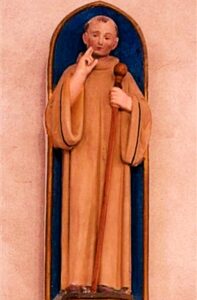 Tours is in western France. (I remember seeing it through the mist as our train sped towards Paris.) Senoch lived about 40 years (536-576). Noted for his austerity and deep humility, after previously living an unfruitful life of vanity. He was able to heal the sick, especially the blind. Saint Gregory of Tours wrote his story, which you can find at: https://www.johnsanidopoulos.com/2014/10/saint-senoch-healer.html
Tours is in western France. (I remember seeing it through the mist as our train sped towards Paris.) Senoch lived about 40 years (536-576). Noted for his austerity and deep humility, after previously living an unfruitful life of vanity. He was able to heal the sick, especially the blind. Saint Gregory of Tours wrote his story, which you can find at: https://www.johnsanidopoulos.com/2014/10/saint-senoch-healer.html
New-Martyr Bishop Laurence of Balakin
“New martyr” is an Orthodox term for one martyred in recent centuries – of which Orthodoxy has had many under the Mongols, Turks and Communists. Laurence was a pious and holy Russian bishop who was executed on this day in 1918 by the Bolsheviks. He had foreseen his death many years before. A full and very moving account of his death and the circumstances surrounding it can be found on the website of Saint Laurence Russian Orthodox Church, McKinney, Texas: https://www.orthodox.net
Saint John the Hermit of Pskov
John lived an ascetic life for 23 years within the walls of Pskov, a city in western Russia, at a time of great troubles. Russia was weak, caught for seven years between the invading Swedish * and Polish armies. Food was scarce. John ate next to nothing, and what he chose to eat, they said, was rancid. It was only weeks before Saint John’s death that Pskov was delivered from the Swedes – which deliverance was attributed to the Pskov Caves icon of the Mother of God. It was said “he lived within the city as though in a wilderness, in great silence.”. Saint John died on October 24, 1616.
- The Swedes! How times change.
Martyr Sebastiane
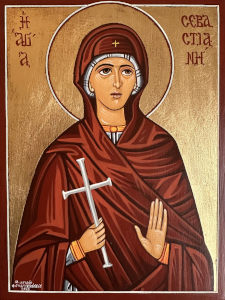 This is a misprint on Orthowiki.com. It should read not “Sebastian” but rather “Sebatiane” or “Sebastiana”.
This is a misprint on Orthowiki.com. It should read not “Sebastian” but rather “Sebatiane” or “Sebastiana”.
She was a disciple of the Apostle Paul. During persecution under the Emperor Dometian. She was taken to a governor Georgios, before whom she confessed her faith in Christ. After cruel torture she emerged unharmed, so they sent her to the city of Heraklea where again she confessed her faith before the governor Pompian. Again they subjected her to tortures, till finally she was taken to be eaten by wild beasts, who refused to touch her. (Why so many ever-more-threatening tortures? Because the authorities wanted the mob to see a Christian deny the faith.) The governor lost patience and had her beheaded. Her body was thrown into the sea, where it was said she was taken by angels to the island of Rhodes.
Saint Maglorios (or Magloire), Abbot of Sark
Sark, in case you didn’t know (I didn’t), is an English island in the southwest English Channel, just off the coast of Normandy
Saint Maglorios was a 6th-century monk and later Abbot of Dol in Brittany. Details of his life are sketchy, as is true of many early Celtic saints, but he is known to have founded many monastic communities and guiding them well. He was respected for his humility and pastoral care. And that’s all we know. Late in life he retired to the island of Sark.
Martyrs Mark, Soterikos, and Valentinos
These saints were from “Asia”, which in those days meant what we call “Asia Minor”, now Turkey. In the year 304 during the Great Persecution under Emperor Diocletian they were arrested because they were Christians. After many tortures, finally they were dragged over sharp stones till they were dead. A man named Terrentianos took their relics to the island of Thassos, off the Greek coast just east of Mount Athos, where they lie today. Apparently miracles take place there to this day. In Slavic usage they are commemorated on October 27.
Saints Akakios the Presbyter and Nerdon
All we know about these two is that Saint Akakios was martyred by the sword, while Nerdon died by fire.
Icon “Joy 0f all who sorrow”
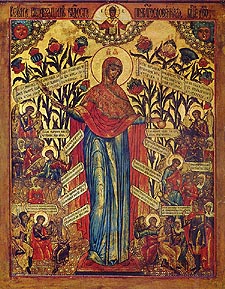
In Moscow in the 17th Centuruy this icon became famous because of a miracle which occurred for Euphemia, the sister of Patriarch Joachim. This poor woman lay suffering because of an infected wound in her side, so great that her internal organs were visible. As she lay waiting for death, she received the Holy Mysteries, then began to cry out to the Mother of God for help. She then heard a voice * directing her to the Church of the Transfiguration in the city, to a certain icon of the Theotokos, the Joy of All Who Sorrow in that church.
- These things do happen, brothers and sisters. They are not like audible voices. They are impossible to explain in words.
She asked the priest of that church to bring that icon to her. He did so, and offered a Molieben * with the Blessing of Water, and Euphemia was healed on this day, October 24, 1688. A feast was established in honor of the icon and of the power of the Mother of God to bring healings to many through this icon.
- a service of prayer in the Slavic tradition
Blessed Elder Zosimas (Verkhovsky)
He was a hesychast, a holy man of the Siberian wilderness during the Nineteenth Century. I have been searching without luck for a biography short enough that I can absorb * and condense it in time for this Post. You can read his life in full, written by his niece and disciple: Holy Spirit in Russia Series ; Vol. 6) by Vera Verkhovsky and Abbess V. Verkhovsky
- It is now late Thursday, the Post goes out tomorrow, and I’m running out of time. Besides, after researching all day my mind is now “fried”, as they say.
In producing this Post, I have learned a lot that I didn’t know before, much of which I’ll no doubt soon forget, and probably you will, too. However, here’s the point: Take all today’s saints and multiply them by 365. Do you feel “surrounded by a great cloud of witnesses”? I do.
By the way, there are (believe it or not) also more Orthodox saints on October 24 – found, for example, on John Sadinopoulos’ Mystagogy Blog and elsewhere. Just search “Saints of October 24”. If you want to research further, be my guest.
If I have made any errors in what I’ve written today (and I probably have), please correct me.
Next Week: And now for something completely different: Boo!
Week after Next: Saint Olga of Alaska
Other sources consulted in writing today’s Post, besides those mentioned above: Orthodox Church in America, orthochristian.com,

